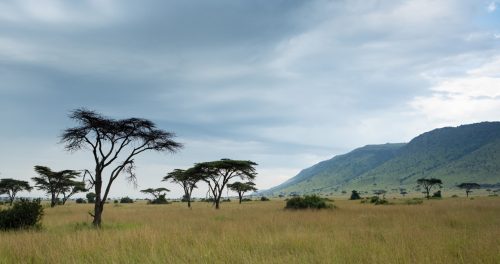The meaning of the word 'Amboseli' in local Maa is 'a salty dusty place'. The soil here is special, a result of the mountain and its past. The mineral-rich earth mixed with rainwater and groundwater, also from the mountain, creates natural salt licks for the animals. From past eruptions, ash and weathered sedimentary rock, form minerals such as sodium bicarbonate and sodium carbonate, vital to herbivores like elephants, zebras and wildebeest. More specifically, they allow for the regulation of electrolyte balance, maintaining proper digestion and strengthening bones, tusks and teeth. This makes the mountain a very special place to this entire ecosystem.
One of the unique birds found both in the Mara and Kimana is the impressive saddle-billed stork. This towering bird can stand up to five feet tall with a wingspan of nine feet. Its massive bill has vibrant red, yellow and black colours. Near Suite #9 at the lodge, a stork has built a large stick nest on the top of a tall tree. The easiest way to tell between male and female storks is the eye colour; females have yellow eyes and males have black. The storks were truly entertaining us this week as while we were out in the Sanctuary we witnessed a stork swallow a small terrapin whole — hard shell included.
Biodiversity comes in all different shapes and sizes. I was lucky to witness the annual migration of a species of butterfly; the brown-veined white butterfly (Belenois aurota). These delicate and beautiful wanderers typically embark on a remarkable journey in December and January that can be hundreds of kilometres long. Millions of these butterflies float gracefully through the long grass in search of food and moisture, drawing them from places with less water. They are not the only kind of butterfly flitting about as bursts of colours are seen everywhere across the landscape.
You cannot come to this part of the country without witnessing some elephants. Not only the Tuskers with tusks that nearly touch the ground but herds of elephants over a hundred strong. Few places on earth have this concentration of these large herbivores. Our guest, Alexander, who visited both the Mara and Amboseli, captured some thrilling experiences with these giants.
Night game drives are one of the many advantages of having exclusive traversing rights in Kimana Sanctuary. Nocturnal animals become active under the cloak of darkness and being on safari at night is a hidden chapter of the wild where familiar landscapes transform under the inky blackness. Your eyes begin to adjust and your other senses become heightened. After seeing various birds, including a beautiful three-banded courser, we saw several scrub hares scattering from bush to bush.
One of the wonderful things about Amboseli National Park is the presence of flamingoes. These beautiful and elegant creatures gracefully walk and fly around the seasonal lakes that form after the rains. There are two species, the lesser and greater, and these highly social animals live in large colonies and can live for up to 50 years in the wild. Their rich pink colour is due to the algae and shrimp they ingest. You can find thousands of these birds scattered around the National Park creating a stunning addition to the environment. –Andrew Andrawes
As per the Kenyan Meteorological Department, the El Niño season is characterised by fluctuations in sea surface temperatures across the equatorial Pacific Ocean. This phenomenon is marked by elevated temperatures in the central and eastern Pacific, leading to above-average warmth. Consequently, this contributes to intensified rainfall and floods, particularly during the short rain seasons of October, November and December, especially affecting East Africa.
Projections and assessments from experts suggest that the heavy rains we are experiencing will still be with us through the early months of this year and align with the typical patterns associated with El Niño. Out on a drive, some roads are muddy and slippery, as the engine roars fighting to get tractions on the muddy road. Beaming with excitement, I am reminded of my childhood, evoking a joyous enthusiasm with every swerve of the car fighting to keep it straight.
Following the nightly or sometimes early morning rains, misty cloudy mornings give way to breathtaking sunrises. The clouds part just enough to allow golden hues to splash across the plains, seemingly infusing life into every element the light touches.
Despite the challenges of heavy rains and flooded roads in certain sections, game viewing remains exceptional in the Triangle. This week, the Salt Lick male provided a delightful sighting with a warthog kill expertly hoisted up a tree, safely out of reach from prowling hyenas. Weaver birds added their melody to the scene, constructing nests undisturbed by the predator's presence.
Abundant grass and water resources have also provided favourable conditions for elephants, prompting them to give birth to new calves. Only a few days old, one such newborn is distinguishable by its pinkish ears, a coat of fine hair and an unsteady walk. At just two to three days old, these young elephants can keep pace with the rest of the herd, showcasing their adaptability in the early stages of life.
With a lot of water come insects, and thus a lot of avian action for bird enthusiasts to relish. –Robert Sayialel
Filed under: This Week at Angama
Subscribe for Weekly Stories
Comments (0):

Angama Safari Camp